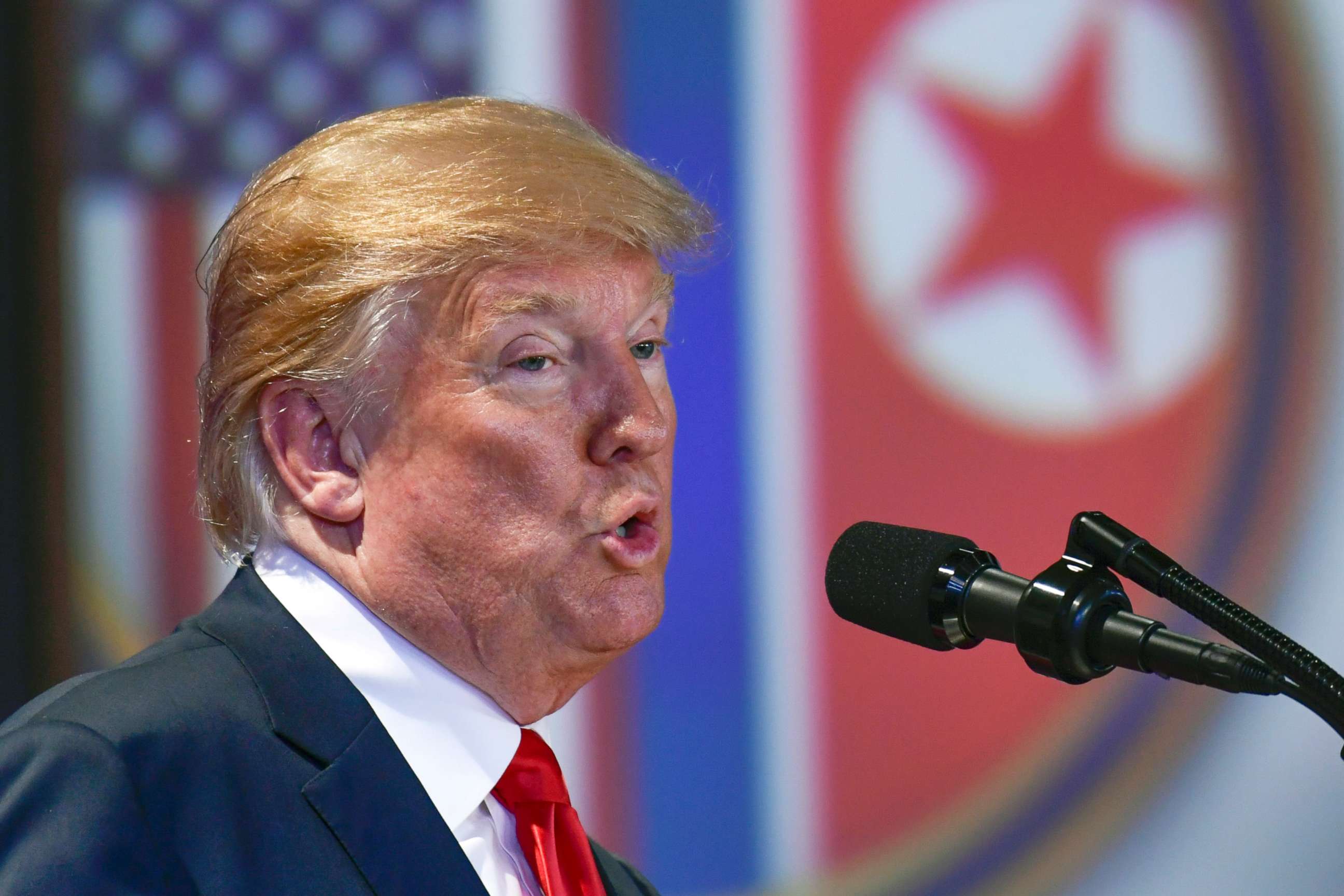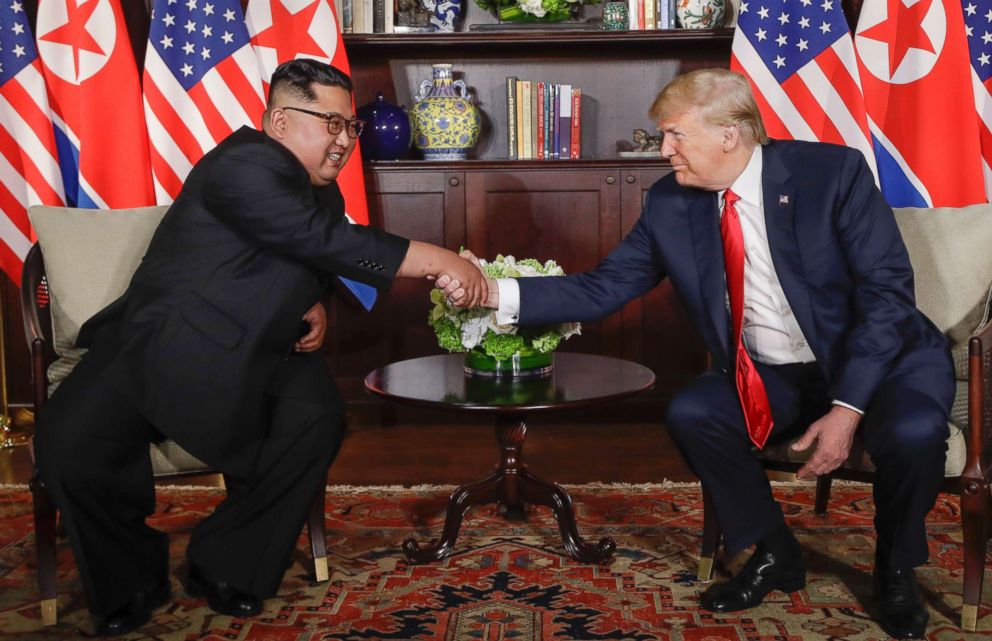Trump and Kim's Singapore summit: Sizing up the winners and losers
Critics say the agreement was very short on specifics.
Flying back from Singapore on Air Force One, President Donald Trump portrayed his summit with Kim Jong Un as a home run.
“Heading back home from Singapore after a truly amazing visit, " he tweeted. "Great progress was made on the denuclearization of North Korea. Hostages are back home, will be getting the remains of our great heroes back to their families, no missiles shot, no research happening, sites closing...”
Earlier Tuesday, after a day of meetings and a long working lunch with advisors, Trump and Kim signed their names in black pen on a one-page agreement. Cameras clicked as Trump proudly presented the document to the world and declared the summit a success.
But once journalists zoomed in on the words of the document, it became clear that beyond orchestrating elaborate international stagecraft and laying the groundwork for peace on the Korean peninsula, the United States did not accomplish many of the goals outlined by officials ahead of the summit. Instead, North Korea’s leader established himself as a global player on the world stage and reaffirmed previous commitments and the United States walked away with many items on its diplomatic checklist unaccomplished.
Secretary of State Mike Pompeo, who was responsible for laying much of the groundwork for Tuesday’s summit, told reporters on Monday the “only outcome the United States will accept” is the “complete and verifiable denuclearization of the Korean Peninsula.” But notably missing from the document signed by Trump and Kim was the word “verifiable.”
“The ‘v’ matters,” Pompeo had told reporters the day before the summit, referring to “verifiable.”
But the agreement reached by both parties was short on specifics or concrete ways the North Koreans plan to work towards denuclearization.
“I read the statement and it's difficult for me to see if something was actually agreed to or not,” Sen. Bob Corker, chairman of the Senate Foreign Relations Committee, said Tuesday.

No outline of how to work toward denuclearization
The No. 1 goal for Tuesday’s summit was to get North Korea to agree to “complete and verifiable denuclearization.” The four agreements outlined in the document signed by Trump and Kim, include establishing new U.S. – North Korea relations, joining efforts for establishing a “lasting and stable peace regime on the Korean Peninsula,” North Korea reaffirming the 2018 Panmunjom Declaration and working toward “complete” denuclearization of the Korea Peninsula, and the North Koreans recovering POW/MIA remains.
Experts were quick to point out that the agreement was short on specifics and only paved the way for more talks between the two countries. The document assigns Pompeo and a “relevant high-level DPRK official” to meet at a later date to “implement the outcomes” of the summit.
In a press conference with reporters after the summit, Trump admitted that he simply did not have enough time to secure the details for “complete, verifiable, irreversible denuclearization.”
“I’m here one day,” Trump said. North Korea has started denuclearization, Trump said. “They blew up their testing site.”
Despite North Korea blowing up one of its nuclear testing sites, the United States failed to secure any kind of timeline for when – or how – North Korea will denuclearize.
No mention of sanctions, U.S. commits to security guarantees for North Korea
Trump said in his post-summit press conference that he wants significant improvement in human rights and the elimination of nuclear weapons in North Korea before the United States lifts sanctions.
“The sanctions will come off when we are sure that the nukes are no longer a factor,” Trump said. “I actually look forward to taking them off and they'll come off when we know we're down the road where it's not going to happen.”
Trump said last week, the U.S. planned to apply additional, new sanctions on North Korea but he decided to hold off.
“I had 300 sanctions I was getting ready to put on last week,” Trump said. “I thought it would be very disrespectful. 300 very big ones, powerful ones, and I said it would be disrespectful.”
North Korea walked away from the summit with “security guarantees” from the U.S. - except that the document does not say what exactly those security guarantees are.

Trump says U.S. will cease military exercises in concession to North Korea
Trump seemed to take his own military and South Korean officials by surprise when he announced that the United States plans to end “provocative” and “expensive” “war games” in the Korean Peninsula. North Korea views military exercises by the United States and South Korea as warm-ups for a potential invasion. On Tuesday, Trump said that while he did not discuss removing U.S. troops from the Korean Peninsula, he does plan on freezing military exercises.
The move is a major win for North Koreans and, especially, the Chinese, who will have an even stronger military foothold in the region.
Trump made his decision, he said, because of the cost, and because North Korea demolished one of their nuclear testing sites.
“You know, we’re spending a fortune, every couple of months we’re doing war games with South Korea, and I said, ‘What’s this costing?’ We’re flying planes in from Guam, we’re bombing empty mountains for practice. I said ‘I want to stop that and I will stop that, and I think it’s very provocative," Trump said.
Japan's key request apparently goes ignored
Japanese Prime Minister Shinzo Abe flew halfway around the world the week before the summit in Singapore to remind Trump of exactly what’s at stake for his country. A chief concern for Japan was the release of Japanese citizens abducted by North Koreans, including one 13-year-old girl abducted almost 45 years ago.
During a press conference with Trump, Abe said Japan’s goals for North Korea are a “comprehensive solution of the abduction, nuclear and missile programs, and to realize real peace in northeast Asia.”
Yet despite Trump’s close relationship with Abe, Japan’s concerns apparently did not come up during his discussions with North Korea, and the issue of abduction was not mentioned in the document signed by Trump and Abe.
China emerges as a winner
Last fall, Trump said that the U.S. government would not accept Chinese President Xi Jinping’s plan for “a so-called 'freeze for freeze'” agreement. A 'freeze for freeze' approach would halt North Korea’s nuclear weapons program in exchange for a stop on American defensive activity in the region.
“President Xi recognizes that a nuclear North Korea is a grave threat to China, and we agreed that we would not accept a so-called “freeze for freeze” agreement like those that have consistently failed in the past,” Trump said in November.
The agreement reached by the United States and North Korea on Tuesday effectively achieves the freeze for freeze China pushed for and the U.S. strongly rejected in the fall.
“For years, China has wanted tensions to cool on the neighboring Korean peninsula and for the U.S. to scale back its military operations in China’s Asian backyard,” Ian Bremmer, president and founder of the Eurasia group wrote in Time. “The U.S., in other words, looks set to become a more marginal player in Asia, much to the delight of Beijing.”
Trump doesn't push North Korea on human rights issues
Once, Trump accused North Korea of having a horrible human rights record, with “no regard” for the “safety and security of its people.”
While Trump said he did bring up North Korea’s record of imprisoning and torturing its own people with Kim on Tuesday, he could not say what specifically he brought up with Kim with regards to human rights.
“Yes, it was discussed,” Trump said. “It will be discussed more in the future, human rights.”
“I believe it's a rough situation over there,” Trump said. “There's no question about it and we did discuss it today. Pretty strongly,” Trump added.
Critics were quick to pounce on Trump’s lack of specifics or progress on the subject of human rights in North Korea, especially after he made a point to highlight a North Korean defector and Otto Warmbier, who died after being held hostage by North Korea, during his State of the Union address.
Former Vice President Joe Biden slammed Trump in a statement.
“While we should never refuse to speak with our adversaries, neither can we ignore the horrendous human rights abuses North Korea’s leaders perpetrate against their own people,” Trump said. “Talking to dictators is one thing; embracing them is another.”
Dictator Kim legitimized on global stage
During their highly orchestrated day in Singapore, Kim, a dictator with an egregious human rights record, had the opportunity to stand side by side with an American president.
Trump lavished praise on Kim over the course of the summit, calling him a “very smart negotiator,” “very talented” leader who “loves his country very much.”
Shaking hands and sharing a meal together was a stark contrast from the insults and fiery language the two leaders hurled at each other from across the Pacific. Trump called Kim “little rocket man” and Kim called Trump a “mentally deranged dotard.”
In the end, Trump was able to say he made progress towards denuclearizing North Korea, and Kim takes home pictures and video of him standing shoulder to shoulder with the most powerful leader in the world.




